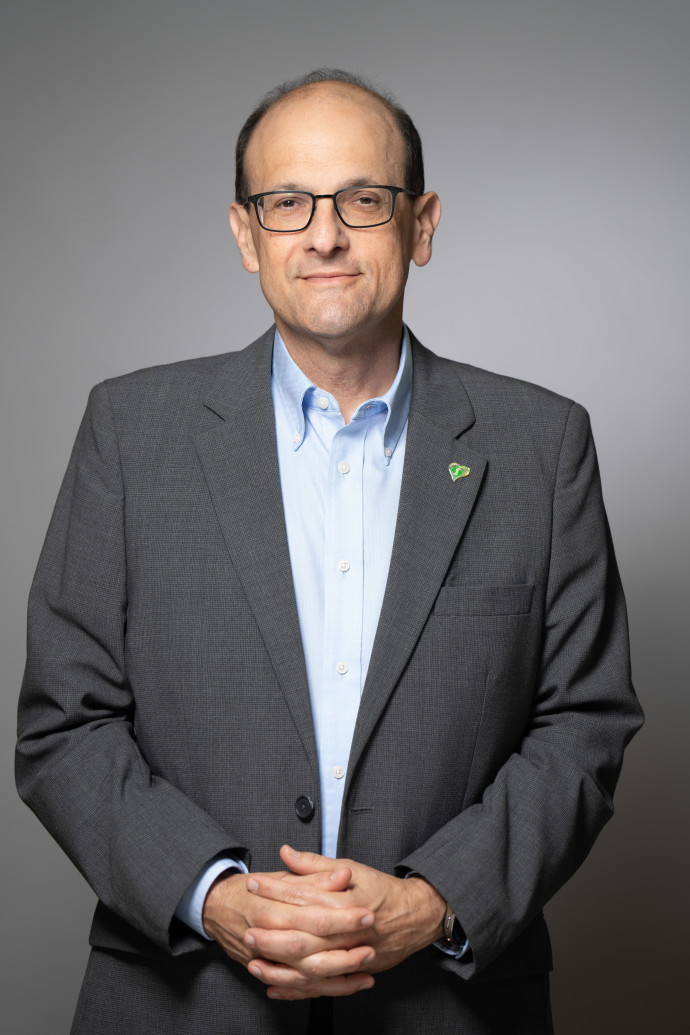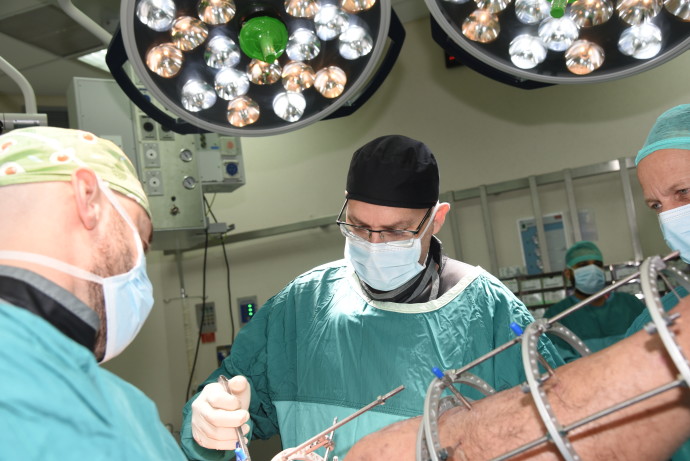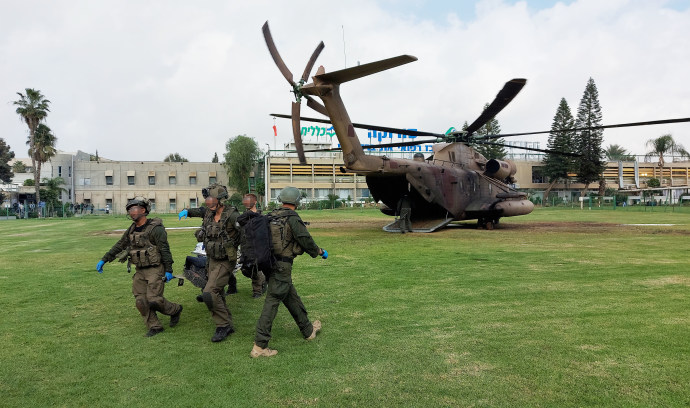Oct. 7 at Soroka was, by far, the largest mass casualty incident in Israeli history, Dr. Shlomi Codish, director-general of Soroka Medical Center, Clalit confirmed earlier this week.
To provide a sense of what it was like for the staff and patients at the hospital in Beersheba, situated just 40 km. from Gaza, Codish began by saying that “69 air raid sirens went off in Beersheba that morning,” heralding a “totally different type of terror attack than we had ever experienced before.”

Whereas “the largest previous such event at Soroka was under 150 casualties, on Oct. 7 we treated 673 people, and in the first two days, over 750.”
Despite the difficulties and complexities involved in treating so many people, some in life-threatening conditions, Codish said that the hospital was not overwhelmed as one might expect.
“We weren’t [overwhelmed], but a lot of work went into not being overwhelmed,” he explained, describing how Soroka managed to cope with the unprecedented number of casualties, both on Oct. 7 and in its aftermath.

“We’ve been on the front line of Israel’s wars since our opening, 65 years ago.” He said that the medical center teams have “a lot of protocols and a lot of experience.”
“In the first half hour [of Oct. 7], we moved all unprotected wards to protected sites, to make sure we didn’t have to worry about protecting staff and patients,” he explained. Other measures included telling the night shift not to go home, “so there was a double shift on hand as early as 7:30 a.m.”
With no time to waste, a “mass casualty incident” was announced at 8 a.m., and the hospital switched to “war protocol.”
Accordingly, all personnel were called back to the medical center, resulting in over 1,700 people coming in to work that day. Twenty-eight nurses and 18 doctors also came in from other Clalit medical centers to help out.
As a result, “We were never short – at any point during the day – of staff to care for patients.”
Additional blood supplies were ordered from Magen David Adom (MDA), another decision that proved vital in saving lives.
In short, the quick thinking of Codish and his team in that dire first hour on Oct. 7 set the tone for the smooth and efficient running of the hospital in the difficult days, weeks, and months that followed.

“The first hour was critical in our hitting the ground running,” he said. “We really didn’t know how big this event was, but potentially overreacting proved to be very instrumental in saving lives.”
Ensuring that there were enough resources to treat the large number of casualties expected was paramount. To that end, they “started sending people home... to make room for incoming casualties,” Codish said.
When the first siren sounded, as many wards as possible were moved into protected areas, although the lack of protected facilities was problematic.
The unprotected operating rooms were only to be used “if lives needed to be saved and there was no other option,” he added.
HOSPITAL SECURITY presented another significant challenge at Soroka. While security forces were engaged elsewhere fighting the terrorists, “Our small security contingency was very rapidly being called up to reserve duty,” leaving them exposed. Nevertheless, the staff continued to work tirelessly as the casualties poured in.
The whole management team handled the day based on “What can go wrong?” Many unprecedented decisions were made, such as calling in the pharmacy team to prepare prescriptions to take some of the pressure off the nurses. Over 50 volunteers also came to help, some bringing food and drink.
“We planned for the worst possible scenario and met a scenario that was five times worse than we had expected,” Codish said.
The staff was faced with “numerous single points of horror,” which were hard to digest at that moment. Young twins were brought in alone, as their family had been slaughtered; and a 22-year-old pregnant woman was admitted with gunshot wounds to her abdomen which had killed her unborn child.
“Understanding the magnitude would probably have made it harder to continue to work,” he said, especially because most of the staff live in the surrounding towns and villages.
“In the first few weeks, our homes were threatened,” which made it very personal.
Soroka lost two staff members on Oct. 7, and others in the days that followed. Dr. Daniel Levy, a resident doctor in the ENT department, was murdered in his clinic on Kibbutz Be’eri while caring for community members. Dr. Eitan Neeman, a senior physician in the pediatric intensive care unit (PICU), was killed in action the day after. Two retired nurses were murdered in their homes on Oct. 7.
Additionally, Nili Margalit, 41, a nurse at Soroka, was taken hostage by Hamas terrorists from her home on Kibbutz Nir Oz on Oct. 7. She was released on November 30, 2023, the day before the IDF confirmed the death of her father, Eliyahu Margalit, whose body remains in Gaza.
Many others were also severely affected: “We’re a very tight-knit community... and there is no one who wasn’t affected,” Codish said.
And the challenges didn’t stop there. On March 31, a senior physician who had treated many war casualties in the hospital’s intensive care unit (ICU) and was serving as a medical officer in Gaza “was brought in – in critical condition – and treated in the intensive care unit he works in.” The tragic irony of the situation was not lost on Codish, who said that the physician is “now in rehabilitation with the soldiers he cared for.”
To date, Soroka has treated over 3,000 casualties arising from Oct. 7, 2,100 of whom are wounded soldiers – numbers which Codish described as “unprecedented.”
Due to its proximity to Gaza (less than 10 minutes by helicopter) and its vast medical expertise, Soroka cares for “the most severely wounded soldiers coming out of Gaza,” which Codish described as a “sacred duty.” Since many arrive with life-threatening wounds, the emergency care team is on call 24/7.
With so many wounded soldiers being cared for at Soroka alone, the enormity of the tragedy that has befallen these young heroes is beginning to become apparent.
“The impact on Israeli society moving forward in terms of rehabilitation and handicapped people living among us is going to be a tremendous shock for most people,” he said, “and that’s before we even talk about mental health.”
AS WELL as caring for wounded soldiers, Soroka treated six hostages after their release from Gaza in November.
“Because Hamas gave no indication of what the medical condition of the hostages was, we only found out once they crossed into Israel and an Israeli doctor had a chance to evaluate them to see if they were going home or not.”
Soroka received siblings Maya and Itay Regev, aged 21 and 18 respectively, as well as two Bedouin teens, Aisha, 16, and Bilal El-Ziadna, 18, whose father and another sibling remain in captivity. One particular hostage, 85-year-old Elma Avraham, who arrived at Soroka after 51 days in captivity, is in serious, life-threatening condition.
“She arrived within an inch of her life,” Codish said.
“We saw Elma lifted from the Hamas vehicle to the Red Cross vehicle, and we knew it was likely she would arrive here. She was airlifted immediately and arrived in a coma. She wouldn’t have survived another day in Gaza.”
Codish explained that “she had significant bone damage on her heels from being dragged along the floor.”
“The lack of basic medication brought her to this condition,” he stressed, as otherwise she “doesn’t have any conditions that are rare or uncommon among her age group.”
This appalling situation “raises the question of how are the other people coping – or are they still alive so many months later?” Clearly troubled by the thought, Codish mused, “As a society, we need to be very concerned and look at Elma as an indicator of what else might be going on [with the remaining hostages].”
The intensive care doctors at Soroka form part of the tight-knit group of physicians across the country who specialize in this medical field. Group members assist each other by sharing ideas: “Our initial work – what worked and what didn’t work – is widely shared so people can learn and prepare,” he said.
Sharing information with medical professionals abroad is a different matter altogether. Having spoken with doctors in the United States, Codish has formed the impression that “people don’t understand the sense of urgency needed to prepare for such events.”
Not only does Soroka take care of the physical needs of its patients, but it also provides mental health support for them and for its staff. “Soroka probably has the best resilience unit in Israel,” Codish stated.
“When we announce a mass casualty incident, the resilience team [social workers, mental health staff, and specifically trained personnel] shows up and follows everything that’s going on.”
The team has been on hand to advise heads of departments and others on how to identify team members who might need help.
Investment in this area is something that Soroka takes very seriously. As it is the only medical center with a Level 1 Trauma Unit in the area, “we need to be prepared for everything.”
“Our capabilities are well known,” Codish said.
“From a medical point of view, we’ve been building strength at the medical center with support from the world – building new units, new capabilities, increasing mental health resilience.”
This article was written in cooperation with Soroka Medical Center.
